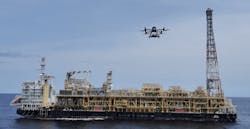TotalEnergies extends drone-based emissions detection globally
Offshore staff
PARIS, France — TotalEnergies is implementing a drone-based emissions detection and quantification campaign across all its operated upstream oil and gas sites worldwide.
For the campaign, it will deploy AUSEA (airborne ultralight spectrometer for environmental applications) technology developed jointly by TotalEnergies, the French National Research Center for Scientific Research and the University of Reims Champagne Ardenne.
AUSEA has been under development since 2017. It comprises a miniature dual sensor mounted on a drone, capable of detecting methane and CO2 emissions while at the same time identifying their source.
Measurements can be taken at offshore and onshore facilities. The system supplements readings taken using established techniques such as infra-red cameras, ground sensors and satellite.
Following tests at locations in Nigeria, Italy, the Republic of the Congo and the Netherlands, TotalEnergies started its campaign in early March at its African offshore sites. The program has since launched in South America and will reach Europe this summer.
The company is pursuing a 50% reduction in methane emissions at its operated complexes by 2025 and 80% by 2030 (targets in relation to 2020). It already has halved its methane emissions at its sites between 2010 and 2020 by focusing on reductions in flaring, venting and fugitive emissions and is introducing stricter design criteria for new facilities.
Further development of AUSEA is underway, allowing it to move from a manual to autonomous deployment, to increase the frequency of methane emission measurements.
In addition, TotalEnergies has pledged to keep methane intensity below 0.1% across its gas facilities.
05.16.2022
